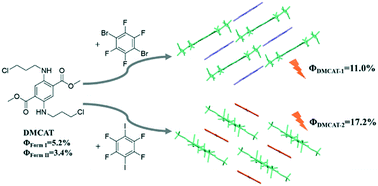Enhanced luminescence of single-benzene fluorescent molecules through halogen bond cocrystals†
Abstract
Organic single benzene fluorescent molecules often suffer from an aggregation-induced quenching effect under solid-state conditions, especially for red-emissive molecules, due to their flat rigid molecular framework and strong π–π interactions. Cocrystal engineering is expected to be a useful tool that can change the packing arrangement and intermolecular interactions inside a crystal through different molecular self-assembly arrangements, which might endow materials with more excellent properties. In this study, two cocrystals of a single benzene X-type luminescent molecule dimethyl 2,5-bis((3-chloropropyl)amino)-terephthalate (DMCAT), namely DMCAT-1 and DMCAT-2, were prepared. Both cocrystals exhibit red shifts relative to DMCAT form II (10 nm and 16 nm) and significantly increased quantum yields (approximately 3 and 5 times). By combining solid-state characterization and theoretical analysis, the mechanism of photophysical property changes and the driving force of molecular self-assembly were explored. It was found that the introduction of co-former molecules weakens the π–π interaction between the DMCAT molecules, thus attenuating the aggregation-induced quenching effect, resulting in enhanced emission.

- This article is part of the themed collection: Editor’s Collection: The application of quantum crystallography to solid-state pharmaceuticals


 Please wait while we load your content...
Please wait while we load your content...